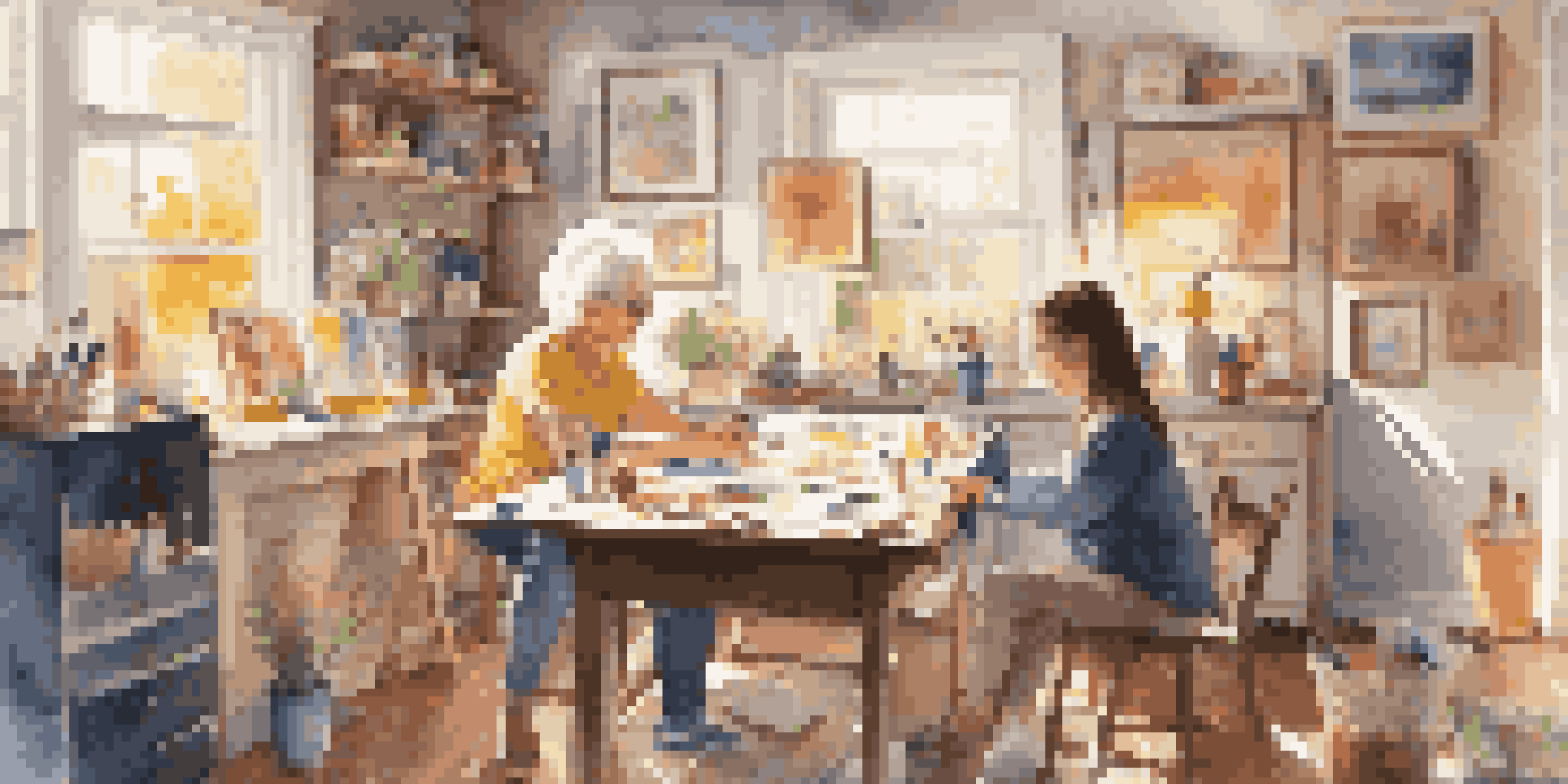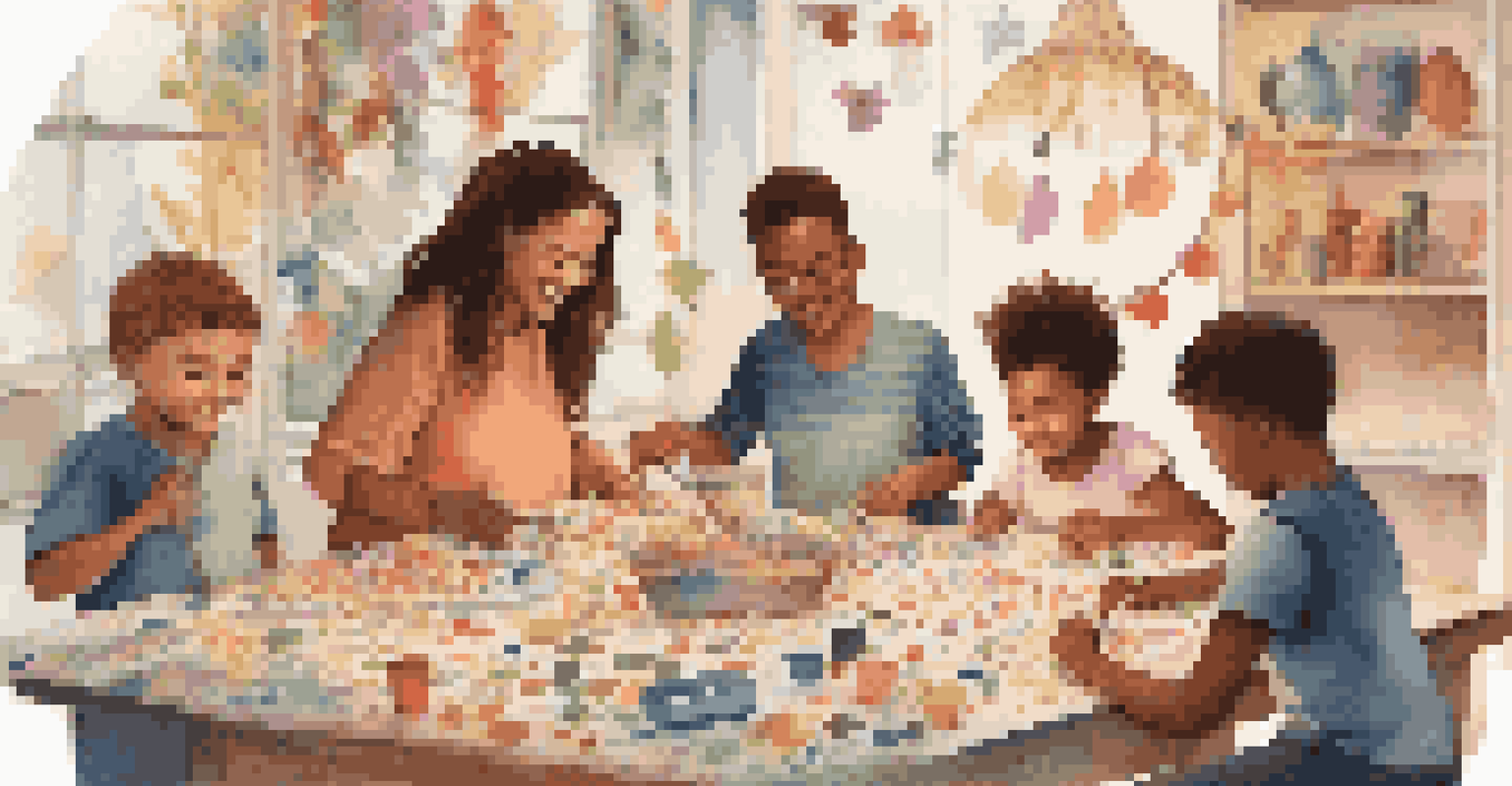Art and Family Relationships: A Cycle of Influence

The Role of Art in Family Communication
Art serves as a universal language that transcends generations. Families often use creative expressions to communicate emotions that might be difficult to articulate verbally. Whether it’s a drawing on the fridge or a family portrait, these pieces can spark conversations and reveal layers of family dynamics.
Art enables us to find ourselves and lose ourselves at the same time.
For instance, a child's artwork might reflect their feelings about family life, while a parent’s creative endeavors can showcase their aspirations or struggles. This two-way street of expression fosters understanding and empathy among family members. Ultimately, art can help bridge gaps in communication, making it easier to discuss sensitive topics.
In this way, art becomes a powerful tool for connection. It encourages families to engage in dialogue, share experiences, and reflect on their relationships—all through the lens of creativity. By embracing art, families can cultivate a deeper understanding of each other, enriching their bonds.
Art as a Reflection of Family Values
Family values often manifest in the art created and appreciated within the home. The themes and subjects chosen by family members can reveal what they hold dear, whether it's love, tradition, or resilience. For example, a family might frequently create artwork depicting cultural symbols, highlighting the importance of their heritage.

Moreover, creative projects often bring families together, reinforcing their shared values and priorities. When families collaborate on art projects, they not only create something beautiful but also solidify their collective identity. This process can instill a sense of pride and belonging in younger members.
Art Enhances Family Communication
Creative expressions help families articulate emotions and foster understanding, making it easier to discuss sensitive topics.
Art, therefore, becomes a living testament to family values. It captures shared experiences and beliefs, preserving them for future generations. In turn, this artistic legacy influences how families view themselves and their place in the world.
The Therapeutic Benefits of Art in Families
Engaging in art can be a therapeutic outlet for family members, providing a safe space to express emotions. This is particularly important during challenging times, as creating art allows individuals to process feelings that might otherwise be overwhelming. Whether through painting, sculpting, or even digital art, the act of creation can promote healing.
Every artist was first an amateur.
For example, families dealing with loss may find solace in creating memorial art together. This collaborative effort not only honors their loved one but also strengthens their bond as they navigate grief. Such shared experiences foster resilience and connection, proving that art can be a powerful source of comfort.
Moreover, these therapeutic benefits extend beyond moments of crisis. Regular artistic engagement can enhance overall family well-being, encouraging open communication, reducing stress, and building stronger relationships. In essence, art can serve as a lifeline for families, helping them navigate the complexities of life together.
Intergenerational Influence of Art
Art has a unique ability to transcend generations, allowing family members to influence one another creatively. Grandparents might pass down traditional crafting techniques, while children introduce contemporary styles and technology. This cyclical exchange enriches the family's creative landscape.
Such intergenerational influence fosters a sense of continuity and belonging. For example, a grandchild learning to paint from a grandparent can create more than just art; they create cherished memories. These moments strengthen family ties and ensure that artistic traditions are preserved and adapted over time.
Art Reflects Family Values
The themes in family-created art reveal shared values and traditions, solidifying their collective identity and sense of belonging.
In this way, art becomes a bridge connecting different generations. It not only reflects family history but also encourages the blending of old and new ideas, enriching the family's collective identity. This cycle of influence highlights the importance of creativity in maintaining strong familial bonds.
Art as a Catalyst for Family Traditions
Families often establish traditions around art-making, creating lasting memories and shared experiences. These rituals can range from annual holiday crafts to collaborative mural projects, each serving to reinforce family bonds. Such traditions not only celebrate creativity but also cultivate a sense of unity and belonging.
For instance, a family may have a tradition of creating handmade decorations for special occasions. These activities not only allow for creative expression but also become cherished rituals that family members look forward to each year. Over time, these traditions can be passed down, enriching the family's narrative.
Art-based traditions thus become integral to a family’s identity. They create touchpoints for connection and reflection, allowing families to celebrate their unique stories. By incorporating art into these traditions, families weave creativity into the very fabric of their lives.
The Impact of Digital Art on Family Relationships
In today's digital age, technology has transformed how families engage with art. From digital painting apps to online classes, the possibilities for creative expression are virtually endless. This accessibility allows families to explore new mediums and collaborate in ways that were previously unimaginable.
For example, a family might participate in a virtual art challenge, each member contributing their unique style. This not only enhances creativity but also promotes teamwork and communication. The digital realm provides a platform for family members to showcase their talents and celebrate each other's work.
Art Resolves Family Conflicts
Engaging in creative activities together allows families to address conflicts in a non-confrontational way, promoting understanding and unity.
However, while digital art offers exciting opportunities, it can also present challenges. Families must navigate screen time and ensure that technology enhances rather than detracts from their relationships. By finding a balance, families can harness the best of both worlds—creativity and connection.
Art as a Means to Resolve Family Conflicts
Art can serve as a non-confrontational means for families to address and resolve conflicts. By engaging in creative activities together, family members can express their feelings in a safe environment. This process can promote understanding and empathy, making it easier to work through disagreements.
For instance, a family facing communication challenges might decide to engage in a group painting session. As they paint, they can discuss their perspectives in a more relaxed atmosphere. The act of creating together can ease tension and open up avenues for honest dialogue.

Ultimately, art acts as a mediator in family conflicts. It encourages collaboration and fosters a sense of unity, reminding family members of their shared goals and values. By using art as a tool for resolution, families can strengthen their bonds and emerge more resilient.